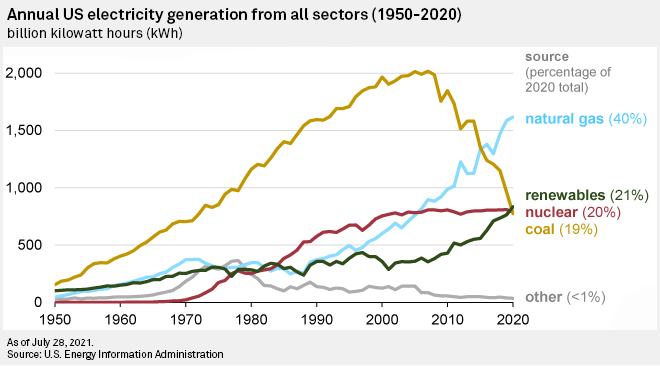S&P Global Offerings
Featured Topics
Featured Products
Events
S&P Global Offerings
Featured Topics
Featured Products
Events
S&P Global Offerings
Featured Topics
Featured Products
Events
Banking & Capital Markets
Economy & Finance
Energy Transition & Sustainability
Technology & Innovation
Podcasts & Newsletters
Banking & Capital Markets
Economy & Finance
Energy Transition & Sustainability
Technology & Innovation
Podcasts & Newsletters
S&P Global Offerings
Featured Topics
Featured Products
Events
28 Jul, 2021
By Justin Horwath
In a milestone for the U.S. electric grid, renewable energy was the second-most prevalent electricity source in 2020, the U.S. Energy Information Administration said July 28.
Renewable energy resources generated a record 834 billion kWh of electricity, 21% of all electricity generated in the U.S. over the year, the EIA said. Only natural gas, which generated 1,617 billion kWh, produced more power than renewable resources, which include wind, hydroelectric, solar, biomass and geothermal.
Nuclear power generated 790 billion kWh, while coal-generated 774 billion kWh.

"This outcome in 2020 was due mostly to significantly less coal use in U.S. electricity generation and steadily increased use of wind and solar," the agency said. Coal generation in 2020 declined 20% from 2019. It is a part of a long decline in the use of coal-fired power, which has fallen off since its peak in 2007 as environmental mandates and cost competition made it a less palatable resource for power generation.
"Coal was the largest source of electricity in the United States until 2016, and 2020 was the first year that more electricity was generated by renewables and by nuclear power than by coal," the EIA said, citing data that dates back to 1949.
Meanwhile, renewable energy generation increased 9% in 2020 from 2019, according to the EIA. Wind, the most prevalent source of renewable power, grew by 14%. Utility-scale solar increased 26%, while small-scale solar increased 19%.
"Nuclear electric power declined 2% from 2019 to 2020 because several nuclear power plants retired and other nuclear plants experienced slightly more maintenance-related outages," the EIA said.
But coal could still regain the number-two spot; the EIA said it expects coal-fired electricity generation to increase in 2021 "as natural gas prices continue to rise and as coal becomes more economically competitive."
The agency projects renewable generation across all sectors will increase 7% in 2021 and 10% in 2022. Nuclear power will decline 2% in 2021 and 3% in 2022, the EIA said.
